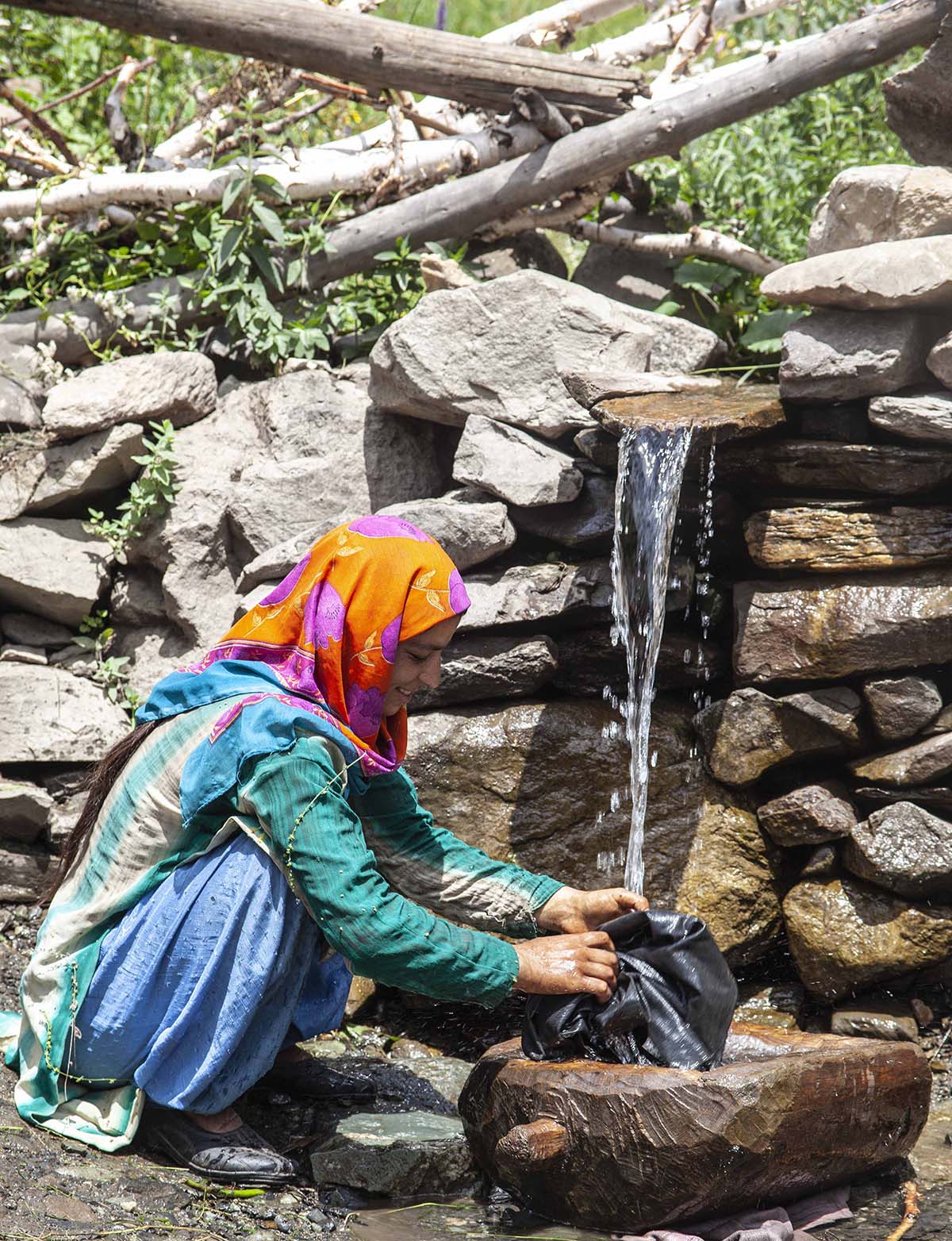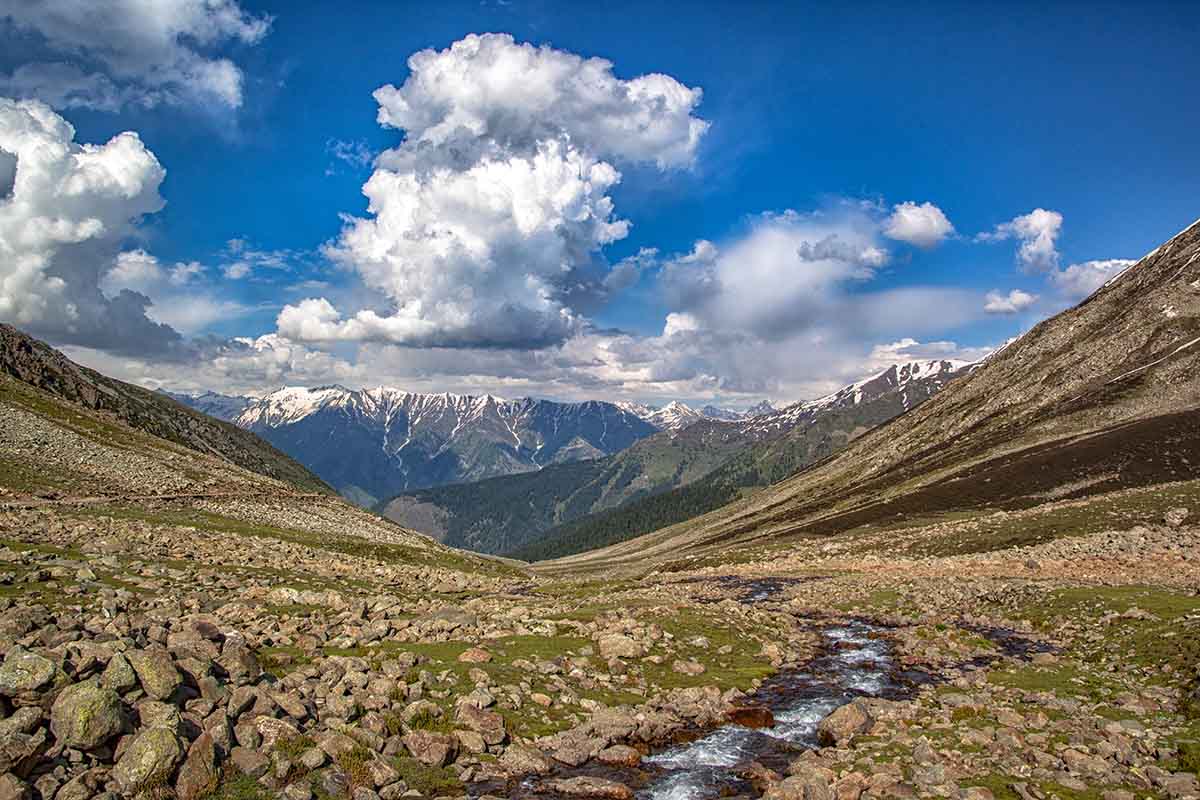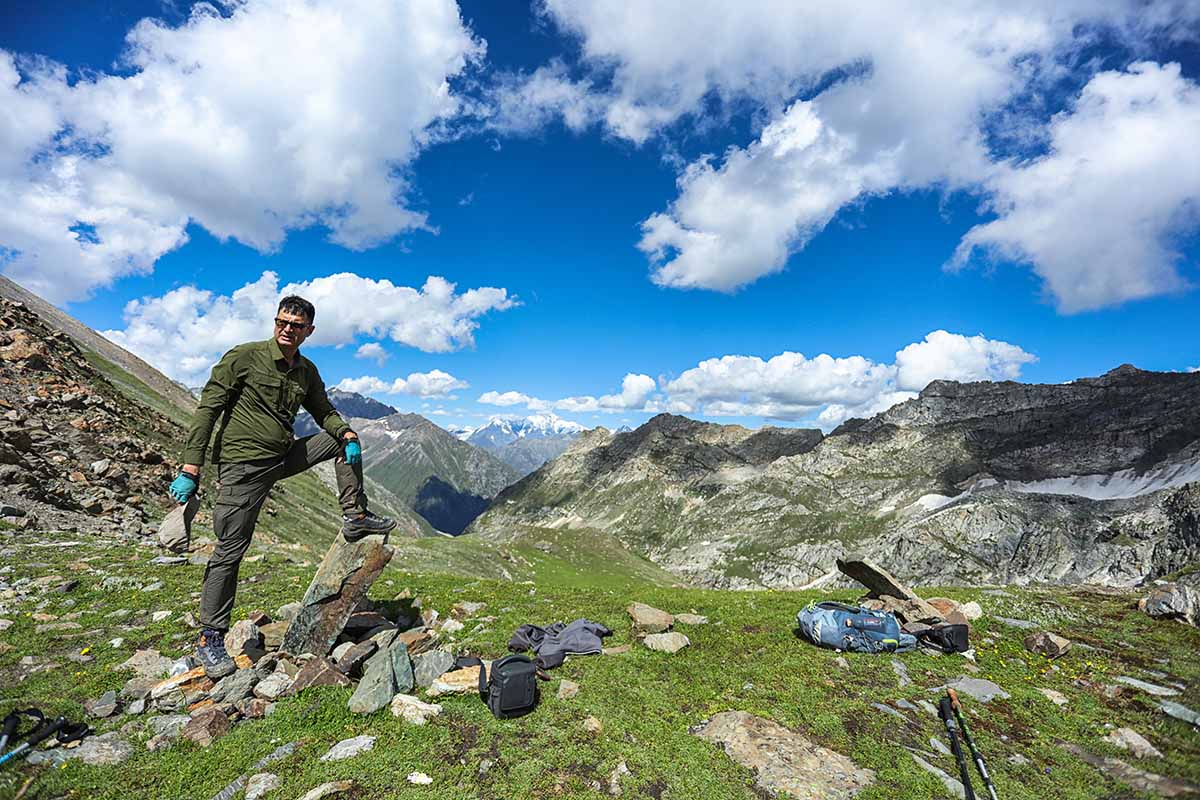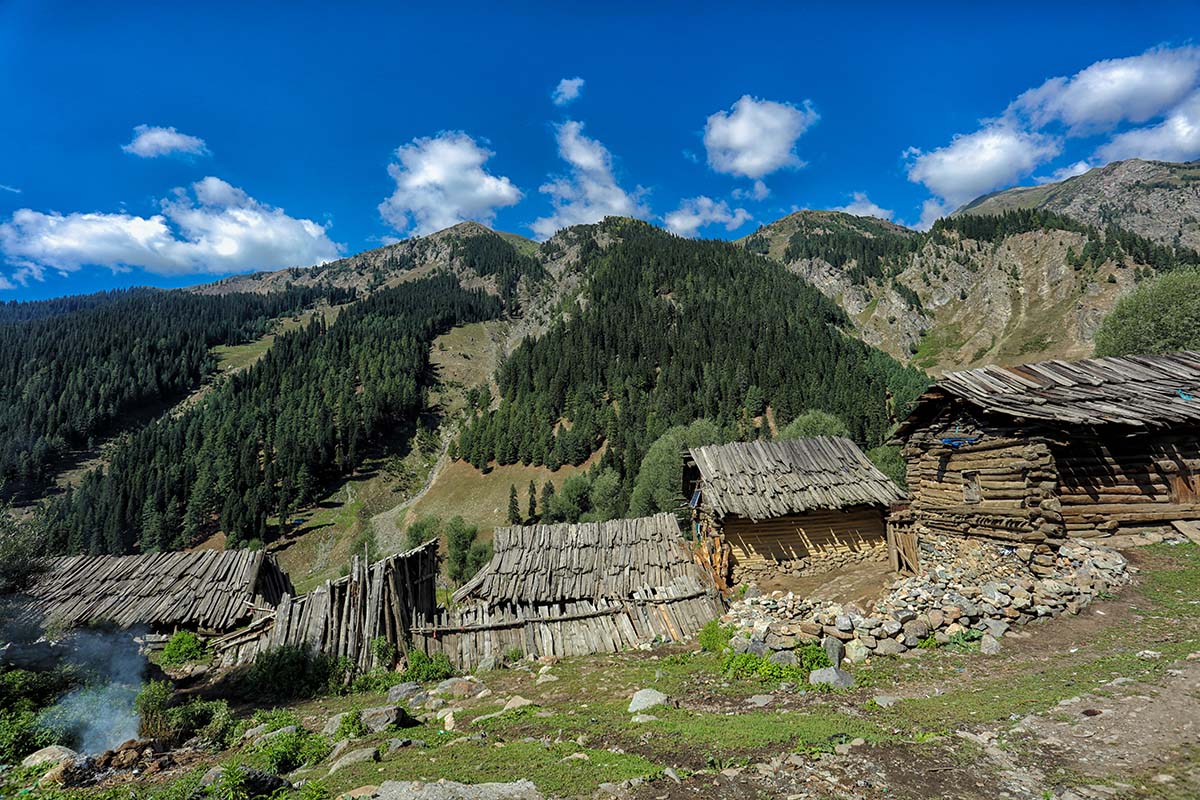Far away from Srinagar is a little Kashmir in Kishtwar shrouded in clouds between Kashmir and Jammu. Administratively part of Jammu, Wadwan is accessible better from Kashmir. A frequent visitor to the region, trekker Mahmood Ahmad, also a government officer, details the miniature and undiluted Kashmir that looks like the peripheral Kashmir of early twentieth century

Rope Bridge: In the twentieth century, rope bridges were abundant in Kashmir and elsewhere. This rope bridge over the Wadwan river is the main bridge connecting the scores of villages inhabiting the two sides. Image: Mahmood Ahmad
As I was walking a level trail, downriver Sukhnai to Basmina, 16 km long stretch which people have used for centuries when I saw a father-son carrying huge hay load on their shoulders. The scene shook me. I requested them to stop for a while to record that moment. Having seen youngsters toiling for living throughout my life, this father-son duo carrying the load gave me a hopeless feeling of a change that this region living over the mountain peaks may ever see.
They live in Wadwan, one of the fascinating picture-perfect landscapes, a photographer’s paradise and a trekker’s heaven. Flat and wide, this valley named after the river that bisects it, is garlanded by towering mountains. Wadwan is the Valley and a village too. The river emanates from Branktan glacier, one of the largest Himalayan glaciers about 20 km in length. Just north of this glacier is the 4434 meters Batkol Pass (also known as Lonvilad) that connects Suru valley with Wadwan. This pass has gradual incline on both sides and its glacier field’s full of crevices that require careful manoeuvring.
Last time, I crossed Batkol pass in August 2009 while trekking from Panikhar (Kargil) to Wadwan. That 5-day trek was my first encounter with this enchanting valley. This was the beginning of my love affair and every few years walk to this valley.

In Basmina village and a family moving out. This photograph is as good as that of Kashmir barring the location. Image: Mahmood Ahmad
Miniature Kashmir
Wadwan is a miniature Kashmir that seemingly is around a century behind Kashmir. Its landscape, culture and human stock are hugely undiluted and largely unadulterated. The wheels of change have moved but very slowly – electricity, plastic, newspapers, cell phones, modern means of transport are yet to reach this valley. Animal husbandry is the major means of sustenance and horse is the beast of the burden outnumbering vehicles by a ratio of 100 to 1 or maybe more.
The pasture abundant valley is home to thousands of herds of sheep, and horses from Kashmir and Jammu. Well before the winter sets in, these temporary migrants return home so do most of the male population that migrates to warmer places for work and labour. The area gets an average 5 to 10 feet of snow during winter that lasts till April. By early May, when sowing starts, the valley is accessible again.

These are considered to be the palatial homes in Wadwan – old style, old Kashmir architecture. Image: Mahmood Ahmad.
Owing to surrounding mountains and the high altitude, there is very little agriculture and no horticulture. People usually cultivate wheat and potatoes. The maize is grown for fodder as it does not bear combs due to climatic conditions. The primary crop, however, is buckwheat (phagopyrum esculantum) that was also the hallmark of Kashmir agriculture for most of the nineteenth and twentieth century in hilly areas. Locally known as Trumb, it is pounded in watermills. Wheat is sown in May and harvested in August and the buckwheat has a June-September cycle.

Till recently, this was the main staple food of the valley – the buckwheat bread. Image: Mahmood Ahmad
Buckwheat flour is baked into bread, the Trumbh Tchut, a staple diet for Wadwan for centuries till the public distribution system guaranteed an assured supply of rice and flour. Collard greens and rice is now the staple diet. Collard green, turnips and beans are grown in the backyard kitchen gardens. Whatever is grown in the area is completely organic. Men and women till the fields.
The First Village
Wadwan, also known as Mul Wadwan, is the main village and the folklore goes that it was the mother village of the belt’s human rootstock. Most of the valley is located on either side of the river. Apart from Wadwan, the villages of Mulwadwan, Inshan, Mungil, Afti, Margi, Gumber, and Rikinwas are on the right bank and Branyan, Chodraraman, Basminah and Sukhnai are on the left bank.

A typical Wadwan family sitting over the perch of their wooden home. Image: Mahmood Ahmad
All these villages are home to impressive anthropological diversity. People usually are fair-skinned, brown-eyed with golden hair. All the inhabitants have suntanned faces. Only Gurez comes closer to Wadwan in certain cases. The entire Wadwan speaks Kashmiri, don the Pheran, use Kangri for winter. All the houses are built of hewn logs and are traditionally two-storied with the ground floor exclusively converted into cowsheds. This is a traditional Kashmir wisdom. Cowsheds keep the first floor warm. Off late, however, the new constructions in the region have started getting modern. Till recently, the houses were traditional but now they are paving way for tin roofs. Some roofs still are wood-shingled.
Charles Ellison Bates in his 1873 Gazetteer of Kashmir has mentioned the Wadwan village comprises of Masjid and four log huts. The 2011 census said the valley has 11 villages with a total population of 8538 souls – 4511 males and 4027 females. All 1592 families live below the poverty line. It is one of the 13 blocks of Kishtwar district; however, the best access to this Valley is from the Kashmir side. Mostly rearing cattle, the valley owns 6.98 lakh cattle heads.
Old Inhabitation
Seemingly, some Kashmiri herders have been impressed by the Valley’s excellent pasturage and felt encouraged to settle down over these heights. Still, almost all the residents have their relations in Kashmir.

Taps will take time, The people in Wadwan use the glacier water for everything and they are healthy. Pic: Mahmood Ahmad
General Zorawar Singh entered Suru valley along with his 5000 cavalry through Batkol in 1834 summer to subjugate Ladakh.
G T Vigne in his 1844 book Travels In Kashmir has mentioned the area. “The view of the noblest description is obtained from the commencement of the descent on either side,” he has written, adding “two very remarkable peaks rise very conspicuously above the other in the distance; they appear to be originally one, and afterwards divided. One is covered with snow; the other dark, being so steep and scarped that the snow will not lie upon it. They have various names among others, Mer and Ser and Nanu and Kanu.”
Just to see these peaks, Arthur Neve, much later accompanied C E Barton. He has written in Thirty years in Kashmir about his travel to see Nun Kun when he crossed Sonsar Pass and entered Wadwan and then proceeded to Suru. Others who have recorded their treks to the Valley include S C Koul, Knight, and A E Ward.

The Wadwan Diversity: These are the people living in Wadwan. Image: Mahmood Ahmad
Recorded History
The region has been explored by countless explorers in the last three centuries. Arthur Brinckman in his 1862 book The Rifle In Cashmere writes that “the country near the Wadwan has the greatest reputation for the ibex.” In his 1915 book Across The Pir Panjal, Dr Arthur Neve writes: “In the late autumn herds of deer cross the valley and ford the river near Inshan making their way up the slopes and through the pine forests on its western bank”. Almost the same year, Captain C M Enriquez’s book The Realm of the Gods mentions: “I think I have never seen such magnificent scenery as in the Wadwan”. Ornithologists like Bates and Lowther visited the valley and traced Ibis bill islands near Inshan. In their book Breeding Birds of Kashmir, they indicated that the delta at Basmina supports a great concentration of Hodgson’s Flinches. Even though a lot of habitat destruction has taken place, the region still is a great space to study birdlife.

This woman and her grand-daughter in their kitchen garden – Kashmir in the mountains. Image: Mahmood Ahmad
These narratives eventually led to small scale efforts by the government to encourage adventure tourism. At the peak of tourism in the 1980s, major travel companies used to conduct Wadwan traverse – a 15-days trek starting from Duksum in Kashmir from via Phamber into Wadwan and then to Batkol pass and Kargil. It used to attract the best of the trekking clientele from the West and the interest was so huge that guides would be hired from Nepal. The bubble burst in 1990. The final death blow came when al-Faran kidnapped a multinational trekking group from Pahalgam in April 1995.
The Al Faran Mess
Adrian Levy and Cathy Scott Clark in their The Meadow note the hikers were bought to Wadwan via Sonasar Gali and were held hostage in a hut at Sukhnai, the last village of Wadwan. Locals corroborate the fact that they were there for many months.

The five western tourists who were hostage by Al-Faran
Even at the peak of militancy, but prior to the al-Faran episode, trekkers were going to Wadwan. Ashraf Batkoo, former Director-General Tourism in Jammu and Kashmir had stayed in the same hut earlier. Huw Kingston and Carol Ankers have mentioned in Alpine Journal 1991 article Kashmir to Kullu Ski Traverse that in 1991 a group of four Nordic skies travelled from Kashmir to Kullu in 32 days, covering a distance of 600 km.
Saga of Sukhnai
Sukhnai is the terminal village of Wadwan located at an altitude of 2800 mts is still not connected by road and requires a 13 km trek to reach the road head at Margi. Sukhnai, however, has twin access treks to Pahalgam – one via Sonsar Gali that meets the yatra trail at Zagipal and the other going upstream bifurcating at Wuntakadal where one turns left towards Gulol Gali to Sheshnag and the other track leads to Batkol Pass into Panikhar.

This is the photograph of the Sukhnai village that was burnt to the last shred. The village is busy reconstructing itself and it is already two years. Image: Mahmood Ahmad
Traditionally, the firewood is stacked close to houses because movement during winters is difficult. This practice has triggered bigger tragedies as fires during winters would destroy complete villages.
Tragically the old Sukhnai went up in flames in October 2016 destroying all the 85 households. The village has since been reconstructed but its primaeval charm is lost. Now, it has around 75 households, a mosque and a shrine and a few shops selling the routine grocery. The main activity, however, is the sale of wool, the major income to the belt.
Last time, I stayed at Sukhnai with Mohammad Amin Lone, the shopkeeper. He recollected the horrors of October 2016 conflagration that erased the village. Amin lost everything and could barely manage to retrieve his clothes. “The fire spread so fast that we could barely escape with our lives,” Amin said. “No fire fighting measure is available in the village.”

Happy Poeple: Disconnected from every place, these people are happier than other living in Jammu and Kashmir. Image: Mahmood Ahmad
Since then the village residents are fighting against odds to reconstruct their homes. Amin, though well off, will take some more time to complete his house.
Farooq, a resident of Anantnag and Amin’s relative said Wadwan valley villages raised donations in cash and kind to supplement the efforts of the government. A lot of aid poured from Kashmir too. Farooq is a frequent visitor to Amin because he purchases wool in wholesale.
No Crime
There is a police presence but the crime is quite rare. Most of the cases, a police officer said are petty brawls over the grazing grounds between Gujjars and Bakerwals or the small Panchayat issues. There are very small cases of elopements that are concluded at the local level.

The cleanest glacier water dripping towards the human habitation near the Margan valley in the periphery of wadwan. Image: Mahmood Ahmad
The absence of a court could a key factor that might be encouraging the community to settle the petty dispute at the local level. Nobody has heard of a murder in the meadow. The road connectivity has improved the transportation of food grains – earlier, it would go on mules from Mati Garwan and now it reaches Inshan, it still is an expensive affair as most of the Madwa and Wadwan still requires mules. In certain cases, sending a kilogram of rice would require twice the cost of transportation alone.
The Faithful
Wadwan is a Sunni Muslim Valley. People have a huge reverence for Sufi Saint Syed Zainuddin Wali. Originally hailing from Bandarkot (Kishtwar), the Wali has been visiting Sukhnai. Most of the springs, stones and legends are associated with him.

One of the high altitude lake in Wadwan valley where an aircraft had crashed. Though nothing much is there, residents have recently traced parts of the rusted engine. Image: Mahmood Ahmad
Besides, there is a shrine attributed to Baba Dawood Guhni at Basmina, another Sufi saint whose sanctum sanctorum is located on a hillock at Guhan (Kokernag). Yet another shrine of Char Yari Ba Safa is at Afti.
My Frequent Forays
I planned my maiden visit to the valley in 2009. On August 14, I started from Panikhar on August 14, camped at Donadu at the base of the Batkol pass. Next day, we crossed the glacier and camped at Kanital for the next three days we managed reaching Inshan where we had a vehicle waiting for us to ferry back home.
Wadwan’s road to Kashmir goes over Margan. It was constructed in 2005 and taking it further upriver and downriver in is still going on. The ambitious project is aimed at connecting Sukhnai upriver with Ikhala in Kishtwar downstream.

Author Mahmood Ahmad at Purmandal Pass on his trek to Wadwan valley in 2020
In subsequent years, I took the trail of Gulol Gali (4406 mts) to enter into Wadwan and returned via Sonasar Gali (4397 mts). Batkoo has mentioned that locals informed him about a plane crash into the Sonsar lake and its tail was still visible. In 2010, I did not find any part of the plane while crossing the pass, later on a few photographs of the crashed plane were sent to me by locals. Crossing the pass requires dismounting of baggage and carrying it manually over a narrower section.
In 2012, I entered Wadwan from Ditap Gali (4036 mts ) also known as Gogisar Gali and was lost for two days in the forest. I started from Batkoot (Pahalgam) and went up the Langnai valley at the base of Gogisar Gali. After crossing the Gali early morning, I got lost in the forest by lunchtime. This trek tested my resolve and I struggled to find my way to Basminah. That was mid-September and all the herders had left the meadows that there was none to guide me. Since my transport was waiting for me in Wadwan and my delay led to the news of my disappearance. They also started searching for me and after two days I could manage to contact them. It turned out to be an adventure of a lifetime.
The valley lacks access to electric power. The residents, however, use solar panels to manage lights and even to power the ceiling fans. The place is so cold that a fan looks like a bull in a china shop but that is a modernity statement by the residents.

Wadwan valley has medival log huts still in use. Pic: Mahmood A Shah
Given the low literacy (56.20 per cent), not many people get government jobs. In 2005, the Jammu and Kashmir Police did special recruitment and appointed 50 boys. Earlier, there were 40 locals serving various government departments, mostly teachers. Almost all the service delivery facilities are managed by locals. But the future seems better – in 27 state-run schools, the cumulative enrolment is 2059. It has 36 Anganwari centre’s with 1265 beneficiaries enrolled and eight 8 health centre’s with a primary health centre at Afti. As I write, I receive disturbing news of Hepatitis B breakout in Wadwan with around 220 active cases.
My latest trek to the region was last month when I started from Batkoot and after reaching Langnai, crossed Sar Gali (4125 mts) and climbed a pass in Purmandal to reach Sukhnai. After a night halt, I walked to Basmina and drove home.
A Road Finally
Reaching Wadwan was completely changed by the road linking Mati Gawran with Inshan. Initiated earlier, the situation delayed it but was finally commissioned in 2005. The 48 km road is operational since 2008 and has ended centuries-old isolation. Following the erstwhile trail, the road crosses the Hatniuk Gali (3691Mts) and descends into Margan valley – the valley of death, named so due to the causalities while travelling the dangerous route.

The general burden: A fascinating picture of a father and son- both residents of Wadwan – carrying the dried up grass for the cattle. Image: Mahmood Ahmad
Most travellers mistake Margan as a pass which in reality is a valley. The actual pass is Hatniuk.
Around Margan are a cluster of high altitude lakes the TcourNag or four lakes, access by a trek of 2.5 km with a gradient of 300 mts. Now it is a popular trekking destination. Adjacent to TcourNag is Zambkash Nag, Khelan Nag and Nagaputi. Towards the south of Margan lie Shil Sar cluster and the Phamber meadow. Wadwan is garlanded by high altitude lakes like Siras Nag, Naganandar, and Sonsar.

These are the Wadwan’s buckwheat fields. Image: Mamood Ahmad
The 7-hour drive from Srinagar requires a good car. Even better cars move slowly from Nowkan. On this entire road, there is only one shelter, a tea-stall at Narbalan. Once in the valley, there are many options – a Dak Bangalow at Inshan and a Forest hut at Afti. Homestays are available in plenty. Many people go along with their tents. A TRC is coming up at Inshan and various huts are under construction at Basmina, Afti, Margi and Wadwan.
Wadwan has a harsh landscape where altitude prevents the growth of remunerative agriculture and horticulture. Ladakh offers worst weather conditions but tourism has been the game-changer for Leh desert. That is where the Wadwan’s future lies.
from Kashmir Life https://ift.tt/3cthujh
via IFTTThttps://kashmirlife.net
No comments:
Post a Comment